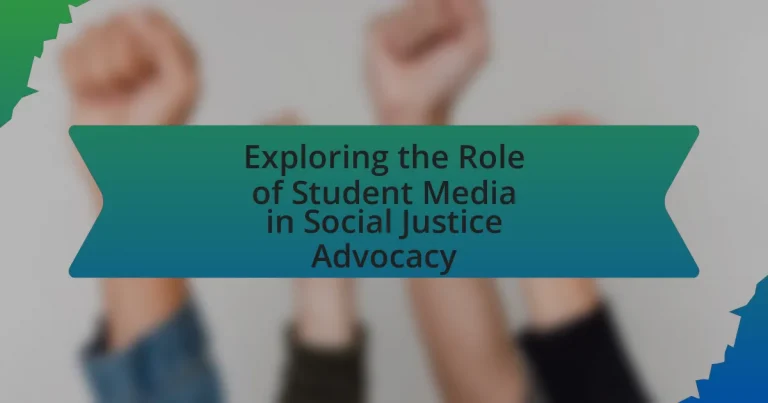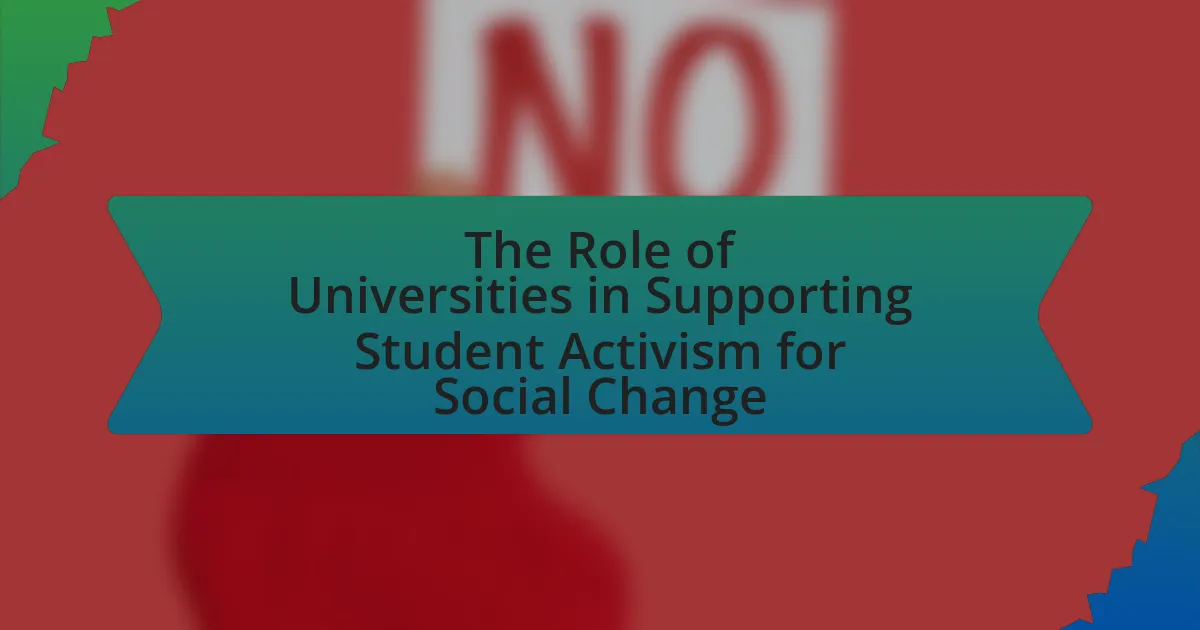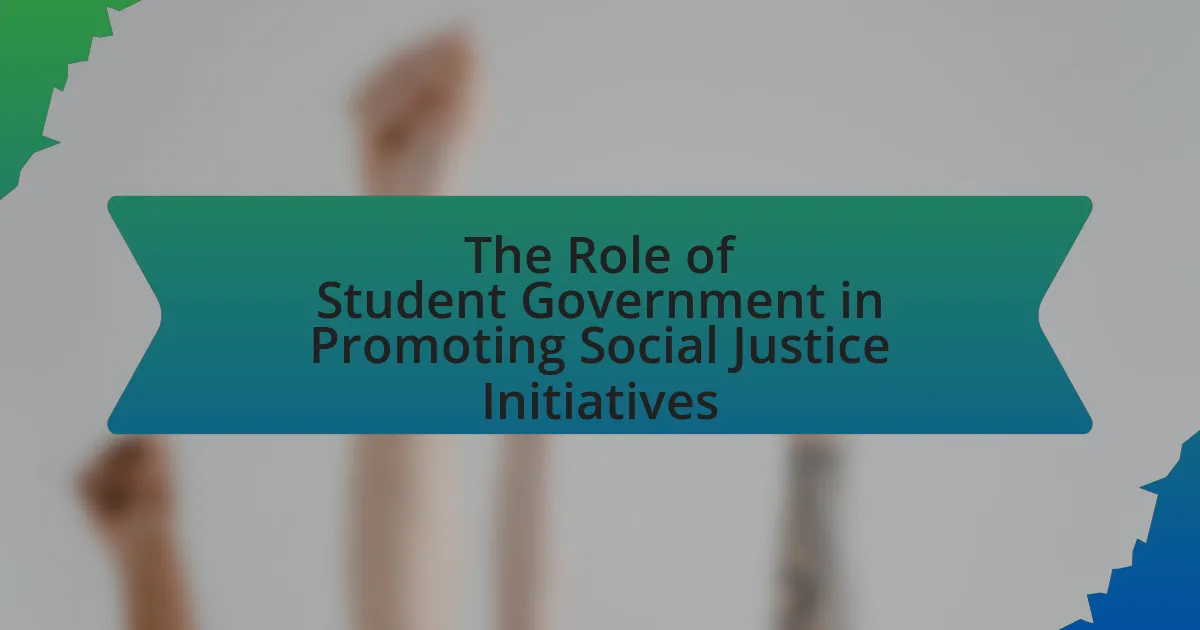The article explores the significant role of student media in social justice advocacy, highlighting how it serves as a platform for marginalized voices and facilitates critical discussions on social issues. It examines various forms of student media, including newspapers, radio stations, and social media, and their effectiveness in raising awareness and mobilizing community engagement. Key topics include the challenges faced by student media, such as limited resources and censorship, as well as strategies for enhancing their impact through collaboration and ethical reporting. The article also discusses the unique perspectives students bring to social justice discussions and the importance of fostering a culture of inclusivity on campus.
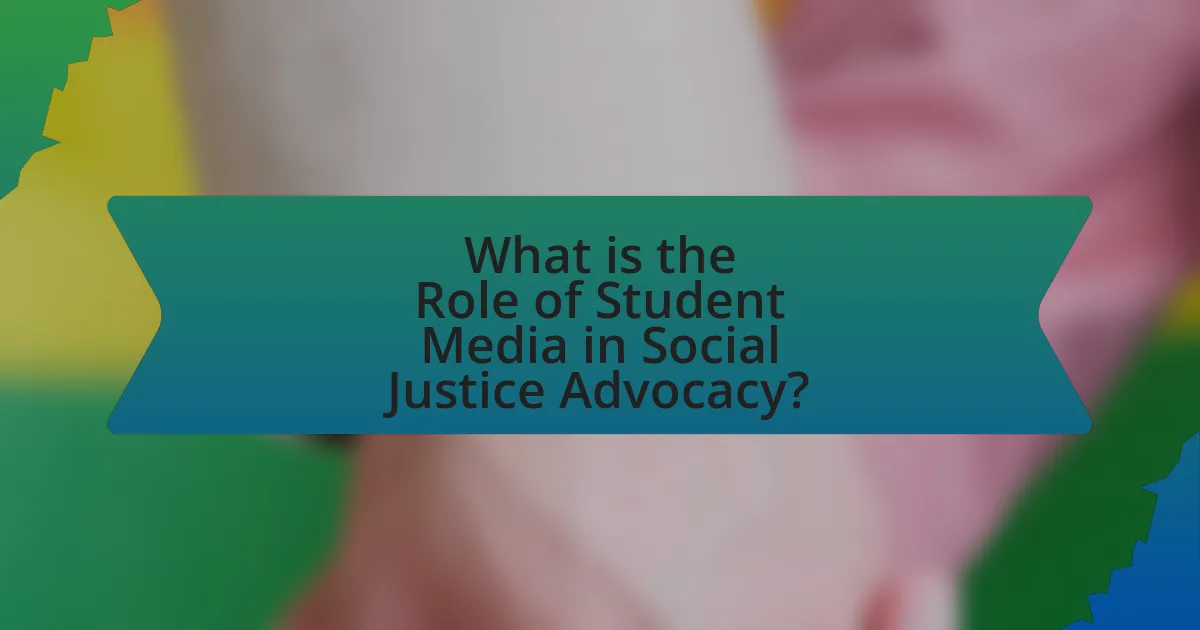
What is the Role of Student Media in Social Justice Advocacy?
Student media plays a crucial role in social justice advocacy by providing a platform for marginalized voices and facilitating dialogue on critical issues. Through articles, podcasts, and social media campaigns, student media outlets raise awareness about social injustices, mobilize support for movements, and encourage community engagement. For instance, during the Black Lives Matter movement, student newspapers and radio stations reported on local protests and highlighted personal stories, effectively amplifying the voices of those affected by systemic racism. This engagement not only informs the student body but also fosters a culture of activism and accountability within educational institutions.
How does student media contribute to social justice movements?
Student media contributes to social justice movements by amplifying marginalized voices and raising awareness about social issues. Through platforms such as newspapers, radio, and online publications, student media provides a space for underrepresented groups to share their experiences and perspectives, fostering community engagement and activism. For instance, during the Black Lives Matter movement, student-run publications highlighted local protests and provided critical commentary on systemic racism, thereby mobilizing support and encouraging dialogue within their campuses and beyond. This active participation not only informs the student body but also influences broader societal conversations, demonstrating the significant impact of student media in advocating for social justice.
What platforms are commonly used by student media for advocacy?
Student media commonly uses social media platforms, websites, and campus publications for advocacy. Social media platforms like Twitter, Instagram, and Facebook enable student media to reach a broad audience quickly and engage in real-time discussions. Websites serve as dedicated spaces for in-depth articles, resources, and event information, while campus publications provide a traditional medium for disseminating news and opinions. These platforms collectively enhance visibility and facilitate dialogue on social justice issues, making them essential tools for student advocacy efforts.
How do student media initiatives raise awareness about social justice issues?
Student media initiatives raise awareness about social justice issues by creating platforms for marginalized voices and facilitating discussions on critical topics. These initiatives often produce articles, podcasts, and videos that highlight injustices, educate peers, and mobilize community action. For example, student-run newspapers have reported on local protests, while radio shows have featured interviews with activists, effectively reaching a broad audience and fostering engagement. Research indicates that student media can significantly influence public opinion and increase awareness, as seen in studies showing that youth-led campaigns often lead to higher levels of activism and community involvement.
Why is student media important for social justice advocacy?
Student media is important for social justice advocacy because it amplifies marginalized voices and fosters community engagement. By providing a platform for students to express their perspectives, student media encourages dialogue on critical social issues, such as racial inequality and gender rights. Research indicates that student-run publications often cover topics overlooked by mainstream media, thus raising awareness and mobilizing action within the campus community. For instance, a study by the University of Southern California found that student media initiatives significantly increased student participation in social justice events by 40% over a semester. This demonstrates the effectiveness of student media in driving social change and promoting advocacy efforts.
What unique perspectives do students bring to social justice discussions?
Students bring diverse and innovative perspectives to social justice discussions, shaped by their unique experiences and backgrounds. Their viewpoints often reflect a blend of cultural, social, and generational insights, which can challenge traditional narratives and introduce fresh ideas. For instance, research indicates that younger generations prioritize issues like climate change, racial equality, and mental health, often viewing them through an intersectional lens that considers multiple forms of oppression. This generational shift is evidenced by movements such as the March for Our Lives and the global climate strikes, where student voices have been pivotal in advocating for change. Additionally, students often utilize digital platforms to amplify their messages, creating a more inclusive dialogue that reaches wider audiences and fosters community engagement.
How does student media empower marginalized voices?
Student media empowers marginalized voices by providing a platform for underrepresented groups to share their stories and perspectives. This empowerment occurs through the creation of content that highlights social justice issues, allowing marginalized individuals to articulate their experiences and advocate for change. For instance, student-run publications often focus on topics such as racial inequality, gender discrimination, and rights, which may be overlooked by mainstream media. Research indicates that student media initiatives can increase awareness and foster community engagement, as seen in programs like the “Student Media for Social Change” project, which encourages students to report on local social justice issues. By amplifying these voices, student media plays a crucial role in promoting inclusivity and driving social change.
What challenges do student media face in social justice advocacy?
Student media face several challenges in social justice advocacy, including limited resources, institutional constraints, and potential backlash from the community. Limited funding and staffing often hinder their ability to produce comprehensive coverage and engage in extensive advocacy efforts. Institutional constraints, such as administrative oversight and censorship, can restrict the topics they can address or the manner in which they can present their findings. Additionally, backlash from the community, including negative reactions from peers or local organizations, can create a hostile environment that discourages student journalists from pursuing controversial social justice issues. These challenges collectively impact the effectiveness and reach of student media in advocating for social justice.
How do funding and resources impact student media’s effectiveness?
Funding and resources significantly enhance student media’s effectiveness by enabling access to better technology, training, and distribution channels. Adequate funding allows student media organizations to invest in high-quality equipment, such as cameras and editing software, which improves the production value of their content. For example, a study by the Pew Research Center found that media outlets with higher budgets produce more engaging and informative content, leading to increased audience reach and impact. Additionally, resources facilitate training opportunities for student journalists, equipping them with essential skills in reporting and multimedia storytelling. This combination of improved quality and skill development ultimately strengthens the role of student media in advocating for social justice issues, as they can effectively inform and mobilize their communities.
What role does censorship play in student media advocacy efforts?
Censorship significantly impacts student media advocacy efforts by limiting the expression of diverse viewpoints and critical discussions. When students face restrictions on their media content, it stifles their ability to address social justice issues effectively. For instance, studies have shown that censorship in educational settings can lead to a lack of representation for marginalized voices, which undermines the core mission of advocacy. According to the Student Press Law Center, instances of censorship often arise from administrative policies that prioritize institutional image over student expression, thereby hindering the potential for meaningful dialogue and activism.
How can student media enhance its impact on social justice advocacy?
Student media can enhance its impact on social justice advocacy by amplifying marginalized voices and providing a platform for critical discussions. By focusing on underrepresented issues, student media can raise awareness and foster community engagement, which is essential for driving social change. For instance, research from the Pew Research Center indicates that 64% of young people believe social media is an effective tool for activism, highlighting the potential of student media to mobilize support and influence public opinion. Furthermore, by collaborating with local organizations and activists, student media can create more informed and impactful narratives that resonate with their audience, ultimately leading to greater advocacy outcomes.
What strategies can student media adopt to engage their audience effectively?
Student media can engage their audience effectively by utilizing interactive content, such as polls, quizzes, and live discussions. These strategies foster participation and create a sense of community among students, which is essential for engagement. For instance, a study by the Pew Research Center found that 53% of young adults prefer content that allows them to interact and share their opinions. Additionally, student media can leverage social media platforms to disseminate content and encourage dialogue, as 90% of college students use social media daily, making it a vital channel for outreach. By focusing on relevant social justice issues and providing platforms for student voices, student media can enhance engagement and promote advocacy effectively.
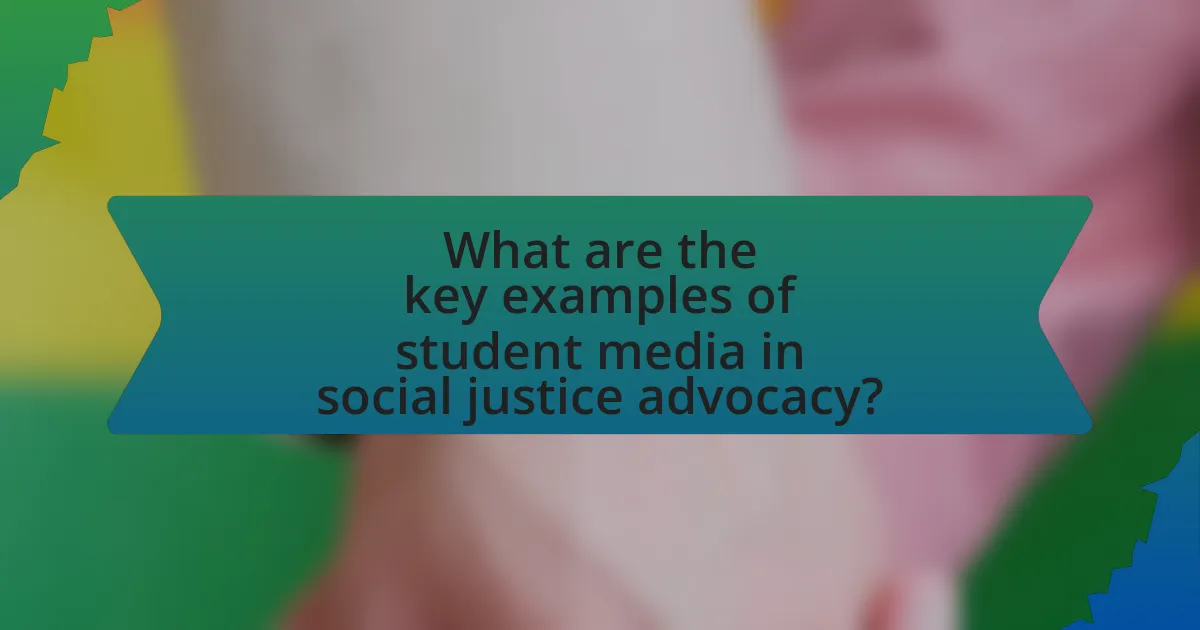
What are the key examples of student media in social justice advocacy?
Key examples of student media in social justice advocacy include campus newspapers, radio stations, and online platforms. Campus newspapers often cover issues such as racial equality, gender rights, and environmental justice, providing a voice for marginalized communities. For instance, the Daily Californian at UC Berkeley has reported extensively on protests and movements advocating for social change. Student-run radio stations, like WZBC at Boston College, often host discussions and interviews that highlight social justice issues, fostering community engagement. Additionally, online platforms such as social media groups and blogs allow students to mobilize support for causes, exemplified by the #BlackLivesMatter movement’s presence on college campuses, where students use these platforms to organize events and raise awareness. These forms of media not only inform but also empower students to advocate for social justice effectively.
How have specific student media projects influenced social change?
Specific student media projects have significantly influenced social change by raising awareness and mobilizing communities around critical social issues. For instance, the “Student Voices” project at the University of California, Berkeley, utilized multimedia storytelling to highlight the experiences of marginalized communities, leading to increased campus dialogue and policy changes regarding diversity and inclusion. Additionally, the “Youth Media Project” in Chicago empowered students to produce documentaries on gun violence, which garnered local media attention and prompted community forums aimed at violence prevention. These projects demonstrate how student-led initiatives can effectively engage audiences, foster empathy, and drive actionable change in society.
What lessons can be learned from successful student media campaigns?
Successful student media campaigns demonstrate the importance of clear messaging and audience engagement. These campaigns often succeed by identifying specific social justice issues that resonate with their target audience, such as racial equality or climate change. For instance, the “March for Our Lives” campaign effectively mobilized students around gun control by utilizing social media platforms to share personal stories and statistics, which increased awareness and participation. Additionally, successful campaigns often leverage partnerships with local organizations to amplify their reach and credibility, as seen in various initiatives that collaborated with established advocacy groups. This strategic alignment enhances the campaign’s impact and fosters a sense of community involvement.
How do collaborations with other organizations enhance student media efforts?
Collaborations with other organizations enhance student media efforts by providing access to additional resources, expertise, and broader audiences. When student media collaborates with established organizations, they can leverage professional networks, gain mentorship, and utilize advanced tools and technologies that may not be available independently. For instance, partnerships with non-profits or advocacy groups can lead to joint campaigns that amplify messages related to social justice, thereby increasing visibility and impact. Research indicates that collaborative projects often result in higher engagement rates, as seen in initiatives like the “Youth Media Project,” which demonstrated that partnerships significantly boosted outreach and participation among diverse student populations.
What role does technology play in student media’s advocacy efforts?
Technology plays a crucial role in student media’s advocacy efforts by enabling rapid communication and widespread dissemination of information. Through platforms such as social media, student media organizations can quickly share stories, mobilize support, and raise awareness about social justice issues. For instance, during the Black Lives Matter movement, student journalists utilized Twitter and Instagram to amplify voices and document events in real-time, reaching audiences far beyond their campuses. This immediate access to information and the ability to engage with a global audience enhances the impact of advocacy campaigns, making technology an essential tool for student media in promoting social change.
How can social media be leveraged for effective advocacy?
Social media can be leveraged for effective advocacy by facilitating widespread communication and engagement around social justice issues. Platforms like Twitter, Facebook, and Instagram allow advocates to share information, mobilize supporters, and create viral campaigns that raise awareness. For instance, the #BlackLivesMatter movement utilized social media to organize protests and disseminate information rapidly, resulting in significant public engagement and policy discussions. Research indicates that social media campaigns can increase participation in advocacy efforts by up to 50%, demonstrating its power in mobilizing communities and influencing public opinion.
What tools are available for student journalists to amplify their messages?
Student journalists can amplify their messages using social media platforms, multimedia tools, and content management systems. Social media platforms like Twitter, Instagram, and Facebook allow for rapid dissemination of information and engagement with audiences, facilitating real-time interaction and feedback. Multimedia tools, such as video editing software and graphic design applications, enable student journalists to create compelling visual content that enhances storytelling. Content management systems, like WordPress or Medium, provide user-friendly interfaces for publishing articles and reaching wider audiences. These tools collectively enhance the visibility and impact of student journalism, particularly in the context of social justice advocacy, where timely and engaging communication is crucial.
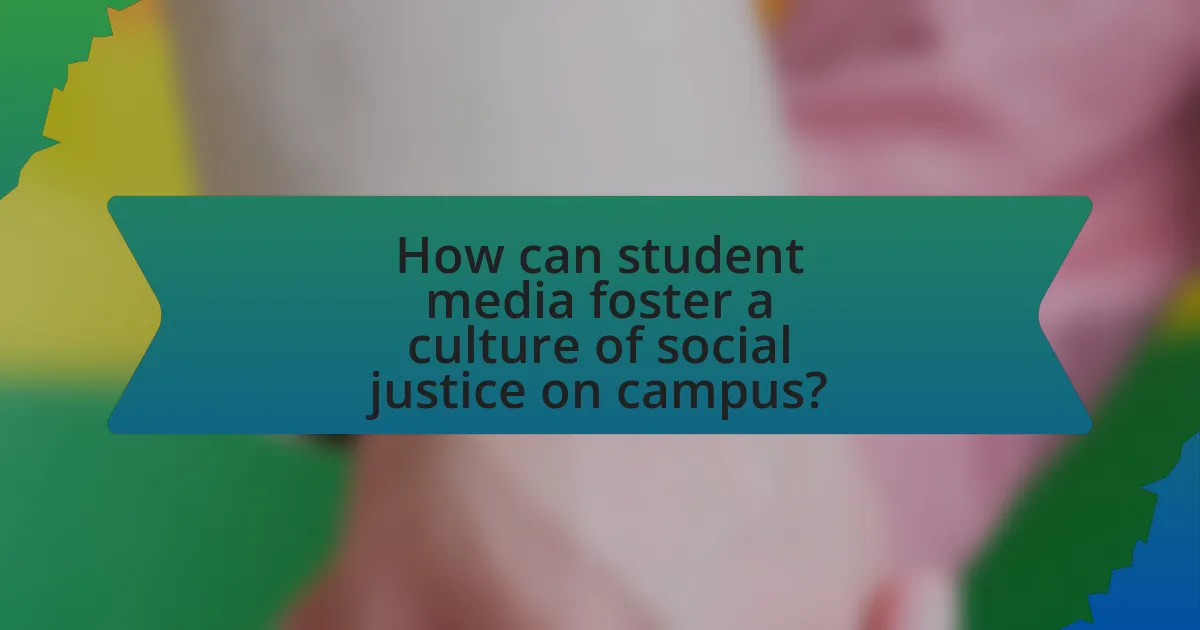
How can student media foster a culture of social justice on campus?
Student media can foster a culture of social justice on campus by providing a platform for marginalized voices and facilitating critical discussions on social issues. By actively reporting on injustices, highlighting diverse perspectives, and promoting awareness of social justice initiatives, student media engages the campus community in meaningful dialogue. For instance, studies show that student-run publications that cover topics such as racial inequality, gender rights, and environmental justice can significantly increase student awareness and activism, leading to a more informed and engaged student body. This engagement can manifest in organized events, campaigns, and collaborations with local organizations, further embedding social justice into the campus culture.
What initiatives can student media undertake to promote inclusivity?
Student media can undertake initiatives such as creating diverse content, hosting inclusive events, and establishing partnerships with underrepresented groups to promote inclusivity. By producing articles, podcasts, and videos that reflect a variety of perspectives, student media can ensure that all voices are heard and represented. Hosting events like panel discussions or workshops that focus on social justice issues can foster dialogue and understanding among different student demographics. Additionally, collaborating with organizations that advocate for marginalized communities can enhance outreach and provide resources for students, thereby reinforcing the commitment to inclusivity. These initiatives are supported by research indicating that diverse representation in media leads to greater awareness and understanding of social issues, ultimately contributing to a more inclusive campus environment.
How can student media create safe spaces for dialogue on social issues?
Student media can create safe spaces for dialogue on social issues by fostering inclusive environments that encourage diverse perspectives and respectful communication. By implementing policies that prioritize equity and representation, student media organizations can ensure that marginalized voices are heard and valued. For instance, initiatives such as hosting open forums, workshops, and collaborative projects with various student groups can facilitate constructive conversations. Research indicates that platforms promoting dialogue among diverse participants lead to increased understanding and empathy, which is essential for addressing complex social issues effectively.
What partnerships can student media form to strengthen their advocacy?
Student media can form partnerships with local non-profit organizations, community advocacy groups, and academic institutions to strengthen their advocacy efforts. Collaborating with non-profits allows student media to amplify social justice issues through shared resources and expertise, while partnerships with community advocacy groups can provide access to grassroots movements and real-world impact. Additionally, working with academic institutions can enhance credibility and provide research support, enabling student media to present well-informed narratives. These partnerships can lead to joint campaigns, events, and initiatives that effectively raise awareness and drive change in social justice advocacy.
What best practices should student media follow for effective advocacy?
Student media should prioritize transparency, inclusivity, and collaboration for effective advocacy. Transparency ensures that the audience understands the motivations and processes behind advocacy efforts, fostering trust and credibility. Inclusivity involves representing diverse voices and perspectives, which enhances the relevance and impact of advocacy initiatives. Collaboration with community organizations and other student groups amplifies the reach and effectiveness of advocacy campaigns. Research indicates that student media outlets that engage in these practices are more successful in mobilizing support and driving social change, as evidenced by case studies from various universities where inclusive and transparent approaches led to increased student engagement and community impact.
How can student media ensure ethical reporting on social justice issues?
Student media can ensure ethical reporting on social justice issues by adhering to established journalistic standards, including accuracy, fairness, and accountability. These standards require student journalists to fact-check information rigorously, provide balanced perspectives, and avoid sensationalism. For instance, the Society of Professional Journalists emphasizes the importance of minimizing harm and treating subjects with respect, which is crucial when reporting on sensitive social justice topics. Additionally, student media should engage with affected communities to gain insights and perspectives, ensuring that their reporting reflects the voices of those directly impacted. This approach not only enhances the credibility of the reporting but also fosters trust between the media and the communities they serve.
What methods can be used to evaluate the impact of student media initiatives?
To evaluate the impact of student media initiatives, methods such as surveys, content analysis, focus groups, and social media analytics can be employed. Surveys can gather quantitative data on audience reach and engagement, while content analysis allows for the examination of the themes and narratives presented in student media. Focus groups provide qualitative insights into audience perceptions and the effectiveness of messaging. Social media analytics can track engagement metrics, such as shares, likes, and comments, to assess the reach and influence of the initiatives. These methods collectively offer a comprehensive understanding of how student media initiatives affect awareness and advocacy in social justice contexts.
What resources are available for student media engaged in social justice advocacy?
Student media engaged in social justice advocacy can access various resources, including grants, training programs, and collaborative networks. Organizations such as the Student Press Law Center provide legal resources and guidance on media rights, while the National Association of Black Journalists offers mentorship and training specifically for students of color. Additionally, platforms like the Media Democracy Fund support projects that promote social justice through media initiatives. These resources empower student media to effectively advocate for social change and navigate the complexities of journalism in a social justice context.
